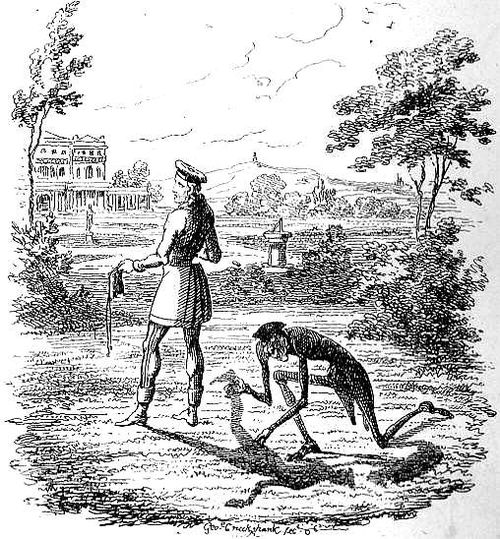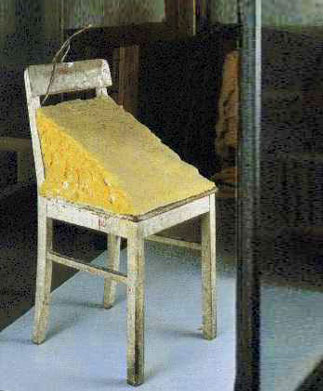JF Ptak Science Books LLC Post 535
On the heels of my last post on the usefulness of constructing geologies of wrongness and on the extraction by Creationists of something from nothing comes today’s bit, where something really does come from nothing, and where (again) nothing of something is extracted from nothing.
The something-from-nothing part with shadows comes from the
odd and somewhat creepy story of Peter Schlemihl (Peter Schlemihls wundersame
Geschichte, "Peter Schlemihl's Remarkable Story") written in 1814 by
the semi-ruined Franco/German aristocrat Adelbert von Chamisso. In one adventure, Peter,
unfortunately poor in a land of the wealthy, makes an agreement with a
mysterious grey man (who is probably the devil) to sell his shadow for a
bottomless purse of gold. In an 1861
British edition of this work, the great George Cruikshank portrays the very
moment when the shadow is being literally lifted from the ground by the
mysterious grey man—the point of contact between his hand and the shadow just
gives me the willies. The grey man’s own
shadow, arching behind him, is also very threatening and terribly offputting to
me. Perhaps it is just a great wrongness, making the shadow something
from its vast nothingness. (And the
story goes that the gold is never-ending, but people are so repulsed by Peter
not having a shadow that it makes his life supremely difficult—so much so that
the grey man returns with a new deal, offering to Peter his shadow and the
endless purse if only he would relinquish his soul when he died. Peter begs off, throws away the purse, and
lives without his shadow and without money.)
2) Nothing from Something from Nothing.
“ ‘Fat Chair’ (1964) is much more about the
physicality of the human body. To Beuys, fat as a material could be considered
before form was considered… Fat…appealed to Beuys b
Another website states “Fat…was an ideal material for Beuys to use to sign chaos and the potential for spiritual transcendence. Fat has the ability to exist as a physical example of two extremes: a flowing liquid when warm and a defined solid when cold. Beuys also believed that fat was psychologically effective, in that "people instinctively feel it relates to inner processes and feelings."
I’m sorry to not include the references for these opinions—it is just to painful, too embarrassing to ascribe them blame. And they are hardly alone in this hagiographic myopia, pulling these strands of something from nothing about nothing.
I’d
prefer to leave it all at nothing in regard to the Beuys (or to Andres Serrano
or Damien Hirst and so on), thinking
about lovely Ludwig’s self-abandoned seventh proposition (“Where (or of what)
one cannot speak, one must pass over in silence”). Better yet, better to apply the one of the
last lines of the great classic “The Street of Laredo” (the Johnny Cash version
of course)—when the young dying cowboy is asked about who shot and killed him,
he simply says, in the best cowboy fashion, “speak not his name, and his name
will pass on.”.





I shall rise slightly above the "My four-year-old can do better than that" response to say that I find this kind of art sophomoric at best. My reason is that one has no response to the thing until one knows either (i) that it is being presented as a work of some kind or (ii) that the slab on the chair is fat. Your response to (i) might be to intellectualize the matter until you have the information in (ii), at which point you'll likely have a visceral response, if only a brief one, that completes the experience at about the level of a sophomoric prank. Or, your response to (i) might be fury at the presumption on your time that kept you from a good book or a football game, and that fury is only fueled by the information in (ii). If the purpose of Art is merely to get a response, then Fat Chair is a work of Art, even if it looks at first like a chance assemblage from the attic. It's hard to go back to Fat Chair for anything after the initial confrontation. Many chance events are worth much more. So we have Art as something less than our normal experience. How lovely. OK, tea's gone ...
Posted by: Jeff | 07 March 2009 at 10:16 AM
Jeff, that's a sharp piece of thinking, and I agree all the way down the line with it. I'm glad you did it because as I reread what I wrote I never did get around to the logic of why I thought Fat Chair was vacant and empty. I just got stuck, fuddled, lost, bored, something...I forgot. I DO thank you for your insight. One thing about me that bothers me is that if Damien Hirst (and his teams) was doing his "art" for medical/anatomical reasons, I'd find it glorious...I have a deep appreciation for medical illustration and so on. But since he is doing his work for the sake of art alone, or art first, I find it one-trick-ponyish, toyish, unappealing. What's up with that?
Posted by: John Ptak | 07 March 2009 at 05:40 PM
I don't know, but I don't blame you. "Hirst" is more like a theater production company. But leaving him behind, I think we do distinguish between things done beautifully and Beauty, things done artfully and Art. It may be a conceptual failing. It may have to do with the perception of purpose. At what point does a beautifully done map become a work of art? I must go check the oven ... preparing to make a beautiful loaf of rye bread.
Posted by: Jeff | 08 March 2009 at 04:40 PM